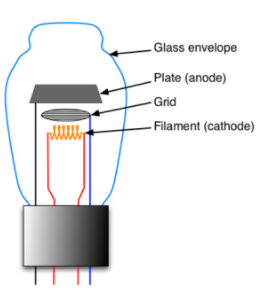Introduction
Some audiophiles have gone so far as to return to classic 1940’s electronic device: the vacuum tube. A small device that you might see glowing through the vents of old radios and TV’s, the vacuum tube, due to its vacuum-tight speed, is truly a valuable design. In fact, it is making a comeback to assist national organizations, such as NASA, with an improved computational speed and reduced space radiation.
The Vacuum Tube’s Story

By 1950, growing technological developments became increasingly demanding in both performance and volume; vacuum tubes could not sustain high frequencies and could not be manufactured quickly. This provoked scientists to revisit an invention first created in 1874: Ferdinand Braun’s “solid-state rectifier”. Through expansive research and implementation, this rectifier eventually led to today’s solid-state transistor [5]. This transistor proved to be a deadly foe for the vacuum tube because of its lower price and increased bandwidth. However, the vacuum tube had a chance at revival through its unique benefits. Current rectification is being reimagined to implement not only the compact size of the transistor, but also the vacuum-tight speed of its vacuum predecessor, which could contribute major benefits to all fields of engineering.
How does it work?

As previously mentioned, the vacuum tube stems off of Edison’s discovery of electrons’ ability to traverse void chambers at fast speeds. So what makes those electrons want to traverse? Commonly, at the starting end of the vacuum tube there is a cathode – a negatively charged electrical conductor that electrons emit from when heated (also known as “thermionic emission” [6]). On the other end is an anode – a device with a positive charge that attracts and catches these negatively-charged electrons. If this anode is hooked up to an electrical device, like a motor, and the neighboring cathode is hooked up to a battery, then the vacuum tube acts as a wall between the device and its power source until the tube’s cathode is heated by a separate power supply. By heating the cathode, the electrons jump from the cathode, zoom through the vacuum, reach the anode, and ultimately connect the battery to its respective device [2].
Bringing Back the Tube

To accomplish this, NASA’s vacuum-channel transistor eliminates the cathode (the electron-emitting component). If the tube is small enough, the electric field across the tube is enough to draw electrons from the attached power source without warming up the cathode. As per traditional solid-state transistors [Fig. 3], the gap between the source and drain is bridged by a silicon dioxide gate which, when electrified, allows current to flow about the gate. By applying this same gate concept, adding a thin oxide layer to insulate the gate, then having the tips of the source and drain separated by nothing but a vacuum, the movement of the current from the source to the drain speeds up. This method eliminates cathode heating and non-vacuum barriers, thus making the device more efficient.
How realistic is the tube comeback?
Clearly, NASA is pushing for scientific revolution and innovation for the vacuum tube, but how relevant will the vacuum tube be in the years to come? Will it be common again? Can it gain popularity on its own without NASA-level development? Jerry C. Whitaker of the Society of Motion Picture & Television Engineers Committee [11] has shared insight on the realism of a tube comeback:
“Although receiving tubes have more-or-less disappeared from the scene, power tubes are alive and well and are performing vital functions in thousands of divergent applications…. Despite the inroads made by solid-state technology, the power vacuum tube occupies – and will continue to occupy – an important role in the generation of high-power radio frequency energy in the high-frequency regions and above. No other device can do the job as well [12].Jerry C. Whitaker
Even if the hardware may be outdated, the analog signal tubes make is still relevant to many. Jon Lloyd of Juno Records, for instance, has commented on the tube’s comforting nostalgia, saying, “People will buy a Kindle for convenience, but people will still want to have a bookshelf” [13]. Even if NASA’s designs are not successful, nostalgia may keep vacuum tubes relevant for decades to come.
References
-
- [1] H. Dylla and S. Corneliussen, “John Abrose Fleming and the beginning of electronics”, Journal of Vacuum Science & Technology A: Vacuum, Surfaces, and Films, vol. 23, no. 4, p. 1244, 2005.
- [2] Electronics at Work. Quality Information Publishers, Inc., 1943.
- [3] E. Barbour, “The cool sound of tubes [vacuum tube musical applications]”, IEEE Spectr., vol. 35, no. 8, pp. 1 – 2, 1998.
- [4] Fredonia.edu. Tube Amps, 2009.
- [5] W. Brinkman, D. Haggan and W. Troutman, “A history of the invention of the transistor and where it will lead us”, IEEE J. Solid-State Circuits, vol. 32, no. 12, pp. 1858, 1997.
- [6] J. Han and M. Meyyappan, “The device made of nothing”, IEEE Spectr., vol. 51, no. 7, pp. 30-35, 2014.
- [7] SeymourDuncan. Triode Vacuum Tube, 2014
- [8] A. Eastman, Fundamentals of Vacuum Tubes, 2nd ed. New York: McGraw-Hill, 1941, p. 22-31.
- [9] M. Meyyappan, “Nanoscale Vacuum Electronics: Back to the Future?”, NASA.gov, 2014. [Online]. Available: http://www.nasa.gov/centers/ames/cct/office/cif/2013/nanoscale_vacuum.html. [Accessed: 20 – Jan – 2016].
- [10] J. Provost. Vacuum Channel Transistor, 2014.
- [11] Smpte.org, “Program Committee | Society of Motion Picture & Television Engineers”, 2016. [Online]. Available: https://www.smpte.org/smpte2014/program-committee. [Accessed 26 – Jan – 2016].
- [12] J. Whitaker, Power Vacuum Tubes Handbook, 2nd ed. Boca Raton: CRC Press LLC, 2000, p. 6.
- [13] M. Gibson, “Here’s Why Music Lovers Are Turning to Vinyl and Dropping Digital”, TIME.com, 2015. [Online]. Available: http://time.com/3663568/vinyl-sales-increase/. [Accessed: 22 – Jan – 2016].




